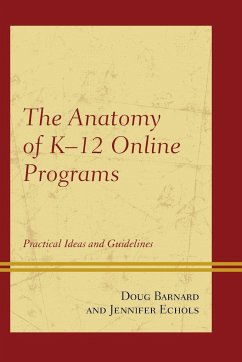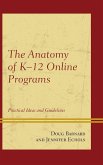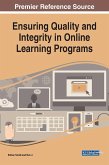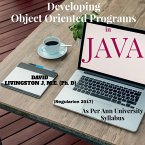- Broschiertes Buch
- Merkliste
- Auf die Merkliste
- Bewerten Bewerten
- Teilen
- Produkt teilen
- Produkterinnerung
- Produkterinnerung
The growth of virtual online programs at the K-12 level is unparalleled in the history of education. This book discusses what constitutes a viable online program and how programs maintain rigorous courses, creditability, and high academic standards.
Andere Kunden interessierten sich auch für
![The Anatomy of K-12 Online Programs The Anatomy of K-12 Online Programs]() Doug BarnardThe Anatomy of K-12 Online Programs68,99 €
Doug BarnardThe Anatomy of K-12 Online Programs68,99 €![Applied Anatomy and Kinesiology; the Mechanism of Muscular Movement. Illustrated With 189 Engravings Applied Anatomy and Kinesiology; the Mechanism of Muscular Movement. Illustrated With 189 Engravings]() Wilbur Pardon BowenApplied Anatomy and Kinesiology; the Mechanism of Muscular Movement. Illustrated With 189 Engravings38,99 €
Wilbur Pardon BowenApplied Anatomy and Kinesiology; the Mechanism of Muscular Movement. Illustrated With 189 Engravings38,99 €![Elementary Anatomy And Physiology Elementary Anatomy And Physiology]() Edward HitchcockElementary Anatomy And Physiology41,99 €
Edward HitchcockElementary Anatomy And Physiology41,99 €![Lucha Libre: Anatomy / Anatomía Lucha Libre: Anatomy / Anatomía]() Patty RodriguezLucha Libre: Anatomy / Anatomía10,99 €
Patty RodriguezLucha Libre: Anatomy / Anatomía10,99 €![Productivity Programs in Schools: Synthesis of the Curriculum Productivity Programs in Schools: Synthesis of the Curriculum]() Sociis Tobias OkolieProductivity Programs in Schools: Synthesis of the Curriculum42,99 €
Sociis Tobias OkolieProductivity Programs in Schools: Synthesis of the Curriculum42,99 €![Ensuring Quality and Integrity in Online Learning Programs Ensuring Quality and Integrity in Online Learning Programs]() Ensuring Quality and Integrity in Online Learning Programs197,99 €
Ensuring Quality and Integrity in Online Learning Programs197,99 €![Developing Object Oriented Programs in Java Developing Object Oriented Programs in Java]() David Livingston JDeveloping Object Oriented Programs in Java13,99 €
David Livingston JDeveloping Object Oriented Programs in Java13,99 €-
-
-
The growth of virtual online programs at the K-12 level is unparalleled in the history of education. This book discusses what constitutes a viable online program and how programs maintain rigorous courses, creditability, and high academic standards.
Hinweis: Dieser Artikel kann nur an eine deutsche Lieferadresse ausgeliefert werden.
Hinweis: Dieser Artikel kann nur an eine deutsche Lieferadresse ausgeliefert werden.
Produktdetails
- Produktdetails
- Verlag: Rowman & Littlefield Publishers
- Seitenzahl: 124
- Erscheinungstermin: 17. November 2014
- Englisch
- Abmessung: 229mm x 152mm x 7mm
- Gewicht: 192g
- ISBN-13: 9781475809824
- ISBN-10: 1475809824
- Artikelnr.: 41248436
- Herstellerkennzeichnung
- Libri GmbH
- Europaallee 1
- 36244 Bad Hersfeld
- gpsr@libri.de
- Verlag: Rowman & Littlefield Publishers
- Seitenzahl: 124
- Erscheinungstermin: 17. November 2014
- Englisch
- Abmessung: 229mm x 152mm x 7mm
- Gewicht: 192g
- ISBN-13: 9781475809824
- ISBN-10: 1475809824
- Artikelnr.: 41248436
- Herstellerkennzeichnung
- Libri GmbH
- Europaallee 1
- 36244 Bad Hersfeld
- gpsr@libri.de
By Doug Barnard and Jennifer Echols
Preface Acknowledgments Introduction Chapter 1: The Current Online
Environment Increasing enrollment in K-12 online programs Common myths
about online learning Essential program components Challenges facing online
programs The oversight of online programs The politics of online learning
Chapter 2: Starting an Online Program Vision, mission, and core beliefs
Identify the Defining Attributes Hire the Staff Awareness of critics
Selection of technology/vendors Chapter 3: Curriculum Options for
curriculum Standards-based curriculum Grade-level appropriate Chunked
curriculum and frequent feedback Flexibility and accessibility
Differentiating instruction for diverse learners Chapter 4: The Potential
Impact of the Common Core The core of the Common Core High stakes tests The
Common Core drives changes Alignment of Common Core standards in online
programs Implications for lesson design in online programs Options for K-12
online programs The bottom line - increased cost Is the Common Core here to
stay? Chapter 5: Academic Integrity What is academic integrity? Academic
integrity builds credibility Shifting societal view of cheating The
politics of cheating Leadership from the state How easy it is to cheat?
Ensuring academic integrity Consequences for cheating Removing the
incentive to cheat Chapter 6: Evaluating Online Teachers and Specialists
Expectations for online teachers Feedback is important Can feedback change
online teacher behavior? Evaluation of program specialists Chapter 7:
Technology, Monitoring & Functions LMS options Monitoring expectations
Other functions of the LMS Chapter 8: Future Trends & Issues Development
and management of online courses Statewide policies Planning for school
closures Appendix A
Environment Increasing enrollment in K-12 online programs Common myths
about online learning Essential program components Challenges facing online
programs The oversight of online programs The politics of online learning
Chapter 2: Starting an Online Program Vision, mission, and core beliefs
Identify the Defining Attributes Hire the Staff Awareness of critics
Selection of technology/vendors Chapter 3: Curriculum Options for
curriculum Standards-based curriculum Grade-level appropriate Chunked
curriculum and frequent feedback Flexibility and accessibility
Differentiating instruction for diverse learners Chapter 4: The Potential
Impact of the Common Core The core of the Common Core High stakes tests The
Common Core drives changes Alignment of Common Core standards in online
programs Implications for lesson design in online programs Options for K-12
online programs The bottom line - increased cost Is the Common Core here to
stay? Chapter 5: Academic Integrity What is academic integrity? Academic
integrity builds credibility Shifting societal view of cheating The
politics of cheating Leadership from the state How easy it is to cheat?
Ensuring academic integrity Consequences for cheating Removing the
incentive to cheat Chapter 6: Evaluating Online Teachers and Specialists
Expectations for online teachers Feedback is important Can feedback change
online teacher behavior? Evaluation of program specialists Chapter 7:
Technology, Monitoring & Functions LMS options Monitoring expectations
Other functions of the LMS Chapter 8: Future Trends & Issues Development
and management of online courses Statewide policies Planning for school
closures Appendix A
Preface Acknowledgments Introduction Chapter 1: The Current Online
Environment Increasing enrollment in K-12 online programs Common myths
about online learning Essential program components Challenges facing online
programs The oversight of online programs The politics of online learning
Chapter 2: Starting an Online Program Vision, mission, and core beliefs
Identify the Defining Attributes Hire the Staff Awareness of critics
Selection of technology/vendors Chapter 3: Curriculum Options for
curriculum Standards-based curriculum Grade-level appropriate Chunked
curriculum and frequent feedback Flexibility and accessibility
Differentiating instruction for diverse learners Chapter 4: The Potential
Impact of the Common Core The core of the Common Core High stakes tests The
Common Core drives changes Alignment of Common Core standards in online
programs Implications for lesson design in online programs Options for K-12
online programs The bottom line - increased cost Is the Common Core here to
stay? Chapter 5: Academic Integrity What is academic integrity? Academic
integrity builds credibility Shifting societal view of cheating The
politics of cheating Leadership from the state How easy it is to cheat?
Ensuring academic integrity Consequences for cheating Removing the
incentive to cheat Chapter 6: Evaluating Online Teachers and Specialists
Expectations for online teachers Feedback is important Can feedback change
online teacher behavior? Evaluation of program specialists Chapter 7:
Technology, Monitoring & Functions LMS options Monitoring expectations
Other functions of the LMS Chapter 8: Future Trends & Issues Development
and management of online courses Statewide policies Planning for school
closures Appendix A
Environment Increasing enrollment in K-12 online programs Common myths
about online learning Essential program components Challenges facing online
programs The oversight of online programs The politics of online learning
Chapter 2: Starting an Online Program Vision, mission, and core beliefs
Identify the Defining Attributes Hire the Staff Awareness of critics
Selection of technology/vendors Chapter 3: Curriculum Options for
curriculum Standards-based curriculum Grade-level appropriate Chunked
curriculum and frequent feedback Flexibility and accessibility
Differentiating instruction for diverse learners Chapter 4: The Potential
Impact of the Common Core The core of the Common Core High stakes tests The
Common Core drives changes Alignment of Common Core standards in online
programs Implications for lesson design in online programs Options for K-12
online programs The bottom line - increased cost Is the Common Core here to
stay? Chapter 5: Academic Integrity What is academic integrity? Academic
integrity builds credibility Shifting societal view of cheating The
politics of cheating Leadership from the state How easy it is to cheat?
Ensuring academic integrity Consequences for cheating Removing the
incentive to cheat Chapter 6: Evaluating Online Teachers and Specialists
Expectations for online teachers Feedback is important Can feedback change
online teacher behavior? Evaluation of program specialists Chapter 7:
Technology, Monitoring & Functions LMS options Monitoring expectations
Other functions of the LMS Chapter 8: Future Trends & Issues Development
and management of online courses Statewide policies Planning for school
closures Appendix A








